Virginia Campus Celebrates 20 Years
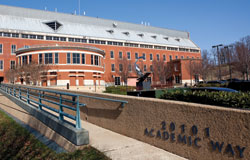
GW's Virginia Science and Technology Campus, located in Ashburn, Va., in Loudoun County, opened its doors in the fall of 1991.
William Atkins
September 2011 marked the 20th anniversary of GW's Virginia Science and Technology Campus. Located in Ashburn, Va., in Loudoun County, the campus has grown into a hub of education and innovation that is propelling some of the university's top research and teaching agendas.
At its 1991 inauguration, the campus spanned 50 acres of land, donated by GW trustee emeritus Robert H. Smith, and one building. Since then, the campus has doubled in size, now occupying more than 100 acres with five buildings, which house state-of-the-art research facilities as well as classroom and lab space for more than 600 students enrolled in the campus' 20 degree and certificate programs. The campus also includes GW's School of Nursing, established in 2010, which offers an accelerated Bachelor of Nursing degree as well as master's and doctoral programs.
Situated in the Dulles Corridor, the campus boasts research centers in transportation safety, renewable energy, and high-performance computing, and is committed to playing an integral role in Northern Virginia's continuing development.
"This campus is and will continue to be a big part of the Virginia technology corridor," said Virginia Secretary of Technology Jim Duffey during his keynote address at the anniversary breakfast in October.
Through a partnership with the Federal Highway Administration and the National Highway Traffic Safety Administration, the campus' National Crash Analysis Center has become one of the nation's leading authorities in automotive and highway safety research. The campus also is home to the East Coast's second-largest earthquake simulator.
In addition, the campus serves its community by hosting more than 100 public events every year and partnering with Loudoun County Public Schools for programs such as the Go Girl Genomics Summer Camp and an annual Science, Technology, and Engineering Day.
New Leadership
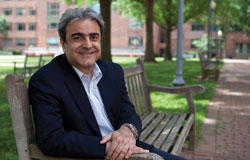
Ali Eskandarian is the new dean of the Virginia Science and Technology Campus. In January, he also will become dean of the College of Professional Studies and dean of the Virginia campuses, which includes education centers in Alexandria, Arlington, and Hampton Roads. Dr. Eskandarian holds a doctorate in theoretical physics from GW and has worked in both academia and private industry. Since 2007, he has served as senior associate dean for strategic initiatives and research at CPS.
Jessica McConnell Burt
In October, the university announced that Ali Eskandarian is the new dean of Virginia Science and Technology Campus.
Dr. Eskandarian is currently a senior associate dean in the College of Professional Studies. He holds a doctorate in theoretical physics from GW and has worked in both academia and private industry. Since 2007, he has served as senior associate dean for strategic initiatives and research at CPS. In January, he also will be come dean of the College of Professional Studies and dean of the Virginia campuses, which include education centers in Alexandria, Arlington, and Hampton Roads. He replaces current CPS Dean Kathleen Burke, who announced her intention to step down as dean effective Dec. 31, 2011. Dr. Eskandarian's combination of academic as well as administrative and entrepreneurial experience makes him particularly well suited for this new role.
"Universities cannot be called great unless they have excellence in certain fields of science and technology," Dr. Eskandarian says. "My pledge is to utilize all the intellectual and physical capital we have here and make this even a greater place."
As the campus looks ahead to the next 20 years, plans are in place for the construction of a new building that will feature 30,000 square feet of academic space as well as 20,000 square feet of space dedicated to new partnership with The Textile Museum (see story, page 30).
—Kelley Stokes
Supporting Community Health Centers
 The Department of Health Policy at the School of Public Health and Health Services has received a $1.75 million gift from the RCHN Community Health Foundation to support the continuation of the Geiger Gibson Program in Community Health Policy.
The Department of Health Policy at the School of Public Health and Health Services has received a $1.75 million gift from the RCHN Community Health Foundation to support the continuation of the Geiger Gibson Program in Community Health Policy.
The Geiger Gibson Program conducts advocacy work through education, training, research, and scholarship on community health centers and the patients and populations they serve. Today, there are more than 1,200 community health centers that serve more than 17 million people in 7,000 urban and rural medically underserved communities across the nation.
This is not the first gift GW has received from the RCHN Community Health Foundation, a nonprofit foundation whose mission is to support community health centers through strategic investment, outreach, education, and health policy research. RCHN first gave the Geiger Gibson Program a $2 million gift in 2007. Since then, the Geiger Gibson Program/RCHN Research Collaborative has conducted extensive policy research addressing the role of health centers in reaching medically underserved populations, the achievements of health centers in improving the quality of patient care, and the continued need for community-based care.
"The Geiger Gibson Program in Community Health Policy has had a major impact on national policy, which will strengthen community health centers, enabling them to provide care to those most in need," Lynn Goldman, SPHHS dean, says. "We are able to continue this important work thanks to the ongoing support and partnership with the RCHN Community Health Foundation."
The policy research conducted by the Geiger Gibson Program served as evidence for the investment in community health centers as part of the Affordable Care Act signed into law by President Obama in March 2010 and other national initiatives.
Established in 2004, the Geiger Gibson Program was named in honor of Drs. H. Jack Geiger and Count Gibson, who founded the nation's first community health centers more than 40 years ago in Mound Bayou, Miss., and Boston.
This research collaborative between the Geiger Gibson Program and the RCHN Community Health Foundation also supports master's and doctoral training and graduate student research assistantships in policy issues; a Distinguished Visitors Program that brings leading figures in the health center movement to the school community; the annual Geiger Gibson Symposium in Health Policy and Emerging Leader Awards program for young professionals; and collaboration on Chronicles, a website that tells the stories and history of health centers and the communities they serve.
"The Geiger Gibson/RCHN Community Health Foundation Research Collaborative was established with the goal of creating an academic home for the study of community health centers," says Julio Bellber, president and chief executive officer of the RCHN Community Health Foundation. "The collaborative's work has been instrumental in the policy arena
and has both complemented and helped drive the foundation's programs in support of health centers. We look forward
to continuing this important partnership with GW."
University Makes Way for the Science and Engineering Hall
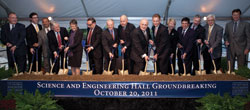
Jessica McConnell Burt
President Knapp, senior university administrators, deans, board of trustees members, and supporters joined together in a ceremonial groundbreaking in October of the Science and Engineering Hall, the university's future state-of-the-art home for its science and engineering departments.
"To be truly the world-class university that we are every day becoming, we need facilities equal to our world-class faculty," Dr. Knapp told about 500 people gathered under a tent beside the construction site.
The event was the official beginning of a planned four-year construction process, with anticipated completion and occupancy by early 2015. The building will nearly double the amount of space available at GW for science and engineering, including 10 floors—eight above ground and two below—for teaching and laboratory facilities, and four underground floors for parking. The building will serve faculty and students in GW's Columbian College of Arts and Sciences and School of Engineering and Applied Science.
A Colonial at Heart
Retiring men's soccer coach leads team to league title in final season.
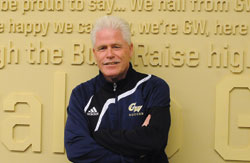
In his 24th and final season at GW, men's soccer coach George Lidster led the team to the Atlantic 10 regular-season league title and was named the league's 2011 soccer coach of the year.
Mitchell Layton
Growing up in a small mining village in northern England, George Lidster never imagined he'd end up coaching soccer at an American university. So as his nearly quarter-century tenure at GW concludes, forgive him if he's still a bit surprised at how far he's come.
"It's been the biggest working part of my life," says Mr. Lidster, who, in his 24th and final season as head coach, was named the 2011 Atlantic 10 Men's Soccer Coach of the Year and led the team to its first regular-season league title since 1992. "I've enjoyed it so much. It hasn't ever felt like a job."
For those who know him, the thought of the most successful coach in program history retiring is, well, kind of strange.
"It's shocking," says assistant coach Craig Jones, who played for Mr. Lidster at GW in the late 1990s. "He's been part of this program for 24 years. I guess you never think he's going to leave it."
Coming into this season, Mr. Lidster had led the Colonials to three NCAA Tournament appearances (1989, 2002, 2004), two Atlantic 10 Tournament championships (2002 and 2004), and a regular-season league title (1992). He leaves with an impressive résumé, especially considering GW isn't a traditional soccer power.
For a while, his team didn't even have a home near campus. During his time at GW, he says, his squads have called six fields—including one about 25 miles away in Virginia—home. At one point, the Colonials were regularly training on the National Mall. "The Park Police tried to arrest me probably every other week," he jokes.
Eventually, men's soccer found a permanent place on the Mount Vernon Campus. Even though the facility's artificial turf field is unlike anything Lidster played on back in England, "it was a great boost to the program," he says. The new digs helped attract recruits.
For Mr. Lidster, wooing talented players was never a difficult proposition. After all, he was once one himself. He remembers his coach at University of Illinois Springfield (it was called Sangamon State when Mr. Lidster was there in the early 1980s) selling him on the school. "He did a great job," Mr. Lidster says. "He made it sound like Los Angeles, Miami Beach, and New York put together. I had to get used to the cornfields."
After a decorated college career in Springfield, Mr. Lidster got a job as an assistant coach at George Mason University. In 1987, he took the reins at GW. Since then, the silver-haired coach has become synonymous with the school's soccer program. That hair is a trademark, says Mr. Jones, who has been named the team's new head coach.
"He's one of the last people who's able to pull off the mullet," Mr. Jones says. "He's kept the mullet as his hair has gotten a little whiter."
Mr. Lidster doesn't think he'll give up coaching for good, but for now, he's excited to be moving on. He plans on relocating to Pawleys Island, S.C., where he'll fish and spend time with his family. Still, it's unlikely that his connection to GW will fray over time.
"I will be a Colonial the rest of my life," Mr. Lidster says. "I will be one at heart and follow [GW] for the rest of my life."
—Alan Siegel
Student-Athletes to Student Leaders
GW is first in Atlantic 10 to offer new leadership academy.
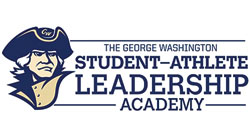 A new program aims to develop the leadership skills of student-athletes with interactive workshops, 360-degree feedback, one-on-one coaching, peer mentoring, and online training.
A new program aims to develop the leadership skills of student-athletes with interactive workshops, 360-degree feedback, one-on-one coaching, peer mentoring, and online training.
"The George Washington Student-Athlete Leadership Academy distinguishes GW as having one of the best leadership development programs in collegiate athletics," GW Department of Athletics and Recreation Director Patrick Nero says. "Not only does this innovative leadership academy maintain and enhance GW's reputation nationally, it provides the department with an advantage in attracting and retaining highly talented student-athletes and coaches."
About 100 of the 433 student-athletes are participating in the program this year, and eventually, the majority of student-athletes on all of GW's 22 teams will participate in some level of the program before they graduate.
The academy is run by Janssen Sports Leadership Center, which manages leadership academies at other top universities, including North Carolina, Michigan, and Yale. According to the company, 85 percent of participants at the schools said the program had a positive effect on their team's performance, and at Michigan, 100 percent of student-athletes improved their leadership scores.
"Our students have a passion for changing the world and programs like this will help them grow to be leaders both in and outside of the classroom," Mr. Nero says.
George Welcomes…
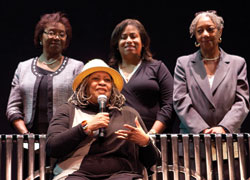 Nobel laureate and Pulitzer Prize winner Toni Morrison spoke at Lisner Auditorium in October about race, American history, and how the free food at an informal writers' group helped spur her to work on her acclaimed 1970 novel The Bluest Eye. The university also dedicated a new bench in Ms. Morrison's honor, commemorating Lisner Auditorium's integration in 1947. Nobel laureate and Pulitzer Prize winner Toni Morrison spoke at Lisner Auditorium in October about race, American history, and how the free food at an informal writers' group helped spur her to work on her acclaimed 1970 novel The Bluest Eye. The university also dedicated a new bench in Ms. Morrison's honor, commemorating Lisner Auditorium's integration in 1947.
Jessica McConnell Burt
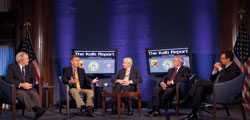 Former news anchors (from left) Charles Gibson, Brit Hume, Dan Rather, and Frank Sesno joined Marvin Kalb (center) for the September season premiere of the "Kalb Report," where they discussed their experiences on 9/11 and the difficulty of covering such an overwhelming series of events. Former news anchors (from left) Charles Gibson, Brit Hume, Dan Rather, and Frank Sesno joined Marvin Kalb (center) for the September season premiere of the "Kalb Report," where they discussed their experiences on 9/11 and the difficulty of covering such an overwhelming series of events.
Jessica McConnell Burt
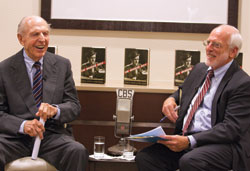 Richard C. Hottelet (left) shared stories from his eight decades in the field as a broadcast journalist, including an encounter with Adolf Hitler, at a master class in August moderated by GW School of Media and Public Affairs Professor and Global Media Institute Director Michael Freedman (right). Mr. Hottelet, who became the only American journalist to be taken prisoner by the Nazis in World War II, began his radio career as a foreign correspondent in Berlin. Richard C. Hottelet (left) shared stories from his eight decades in the field as a broadcast journalist, including an encounter with Adolf Hitler, at a master class in August moderated by GW School of Media and Public Affairs Professor and Global Media Institute Director Michael Freedman (right). Mr. Hottelet, who became the only American journalist to be taken prisoner by the Nazis in World War II, began his radio career as a foreign correspondent in Berlin.
William Atkins
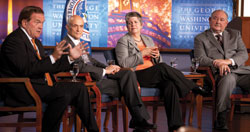 (From left) Former Homeland Security Secretaries Tom Ridge and Michael Chertoff joined current Secretary Janet Napolitano and moderator Adm. Thad Allen, MPA '86, distinguished professor of practice at GW and former commandant of the U.S. Coast Guard, in October to discuss current challenges to homeland security. (From left) Former Homeland Security Secretaries Tom Ridge and Michael Chertoff joined current Secretary Janet Napolitano and moderator Adm. Thad Allen, MPA '86, distinguished professor of practice at GW and former commandant of the U.S. Coast Guard, in October to discuss current challenges to homeland security.
William Atkins
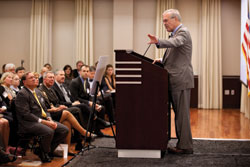 Former U.S. Secretary of Defense Donald Rumsfeld spoke about his transition from the military to public office at the Minutemen Memorial Building in Northeast D.C. The September event was part of the GW Veterans Campaign Distinguished Speakers Series, hosted by GW Veterans Campaign, the Graduate School of Political Management, and the Reserve Officers Association. Former U.S. Secretary of Defense Donald Rumsfeld spoke about his transition from the military to public office at the Minutemen Memorial Building in Northeast D.C. The September event was part of the GW Veterans Campaign Distinguished Speakers Series, hosted by GW Veterans Campaign, the Graduate School of Political Management, and the Reserve Officers Association.
Stephen Fisher
|
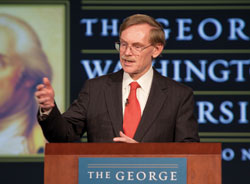 World Bank President Robert Zoellick addressed the new realities of a world in which developing countries account for a growing share of the global economy in a talk titled "Beyond Aid" at the Jack Morton Auditorium in September. World Bank President Robert Zoellick addressed the new realities of a world in which developing countries account for a growing share of the global economy in a talk titled "Beyond Aid" at the Jack Morton Auditorium in September.
Jessica McConnell Burt
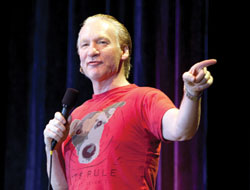 Comedian Bill Maher, host for the past eight years of HBO's Real Time with Bill Maher and No. 38 on Comedy Central's "100 Greatest Stand-Ups of All Time," performed for a sold-out crowd at Colonials Weekend. Comedian Bill Maher, host for the past eight years of HBO's Real Time with Bill Maher and No. 38 on Comedy Central's "100 Greatest Stand-Ups of All Time," performed for a sold-out crowd at Colonials Weekend.
Jessica McConnell Burt
 Renowned D.C.-area chef José Andrés joined his longtime friend Ferran Adrià, former head chef at acclaimed Spanish restaurant El Bulli, at Lisner Auditorium in September to share stories and secrets from their lifetimes spent at the top of the culinary game. Renowned D.C.-area chef José Andrés joined his longtime friend Ferran Adrià, former head chef at acclaimed Spanish restaurant El Bulli, at Lisner Auditorium in September to share stories and secrets from their lifetimes spent at the top of the culinary game.
Jessica McConnell Burt
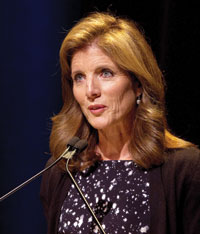
Caroline Kennedy spoke at Lisner Auditorium in September about her mother, Jacqueline Kennedy Onassis, BA '51. The talk, titled after Ms. Kennedy's new book, Jacqueline Kennedy: Historic Conversations on Life with John F. Kennedy, ranged from the late first lady's love for her family, to her devotion to the arts, to her strong opinions on politics. .
Jessica McConnell Burt
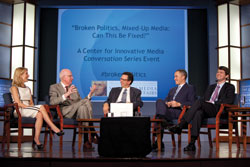 (From left) CNN congressional correspondent Dana Bash, BA '93, former Sen. Robert Bennett, moderator and School of Media and Public Affairs Director Frank Sesno, former U.S. Rep. Harold Ford Jr., and Associate Professor of Political Science John Sides offered their thoughts on the state of the U.S. government and the role of the media in a September panel discussion, "Broken Politics, Mixed-Up Media: Can This Be Fixed?" (From left) CNN congressional correspondent Dana Bash, BA '93, former Sen. Robert Bennett, moderator and School of Media and Public Affairs Director Frank Sesno, former U.S. Rep. Harold Ford Jr., and Associate Professor of Political Science John Sides offered their thoughts on the state of the U.S. government and the role of the media in a September panel discussion, "Broken Politics, Mixed-Up Media: Can This Be Fixed?"
Jessica McConnell Burt
|
At a Glance
A Billion Green
George Washington has joined 32 other universities to launch the Billion Dollar Green Challenge—a commitment to collectively invest $1 billion within two years to finance energy-efficient upgrades on campus.
The university has already established funds toward this goal: In April 2010 GW announced a $2 million revolving fund to improve the energy efficiency of buildings on campus. Since last spring, almost $1 million of that fund has been allocated to sustainable projects, including occupancy sensors, daylight sensors, chilled water connections, summer boiler replacements, and variable speed drive fans. The first year of the project has resulted in savings of $115,000 and avoided 1,000 metric tons of carbon dioxide equivalents, says Sophie Waskow, GW sustainability project facilitator.
The university's newest upgrade will result in three residence halls getting about two-thirds of their hot water from the sun's heat this year. New solar thermal systems were installed this spring and summer in Building JJ, Ivory Tower, and 1959 E Street.
Reducing the campus' carbon footprint is part of GW's Climate Action Plan, which targets carbon neutrality by 2040. By making buildings more efficient, using cleaner energy, and encouraging the community to do its part, the university plans to reduce its carbon emissions by 40 percent by 2025 and 80 percent by 2040. The remaining carbon emissions will be mitigated through the purchase of local offsets.
China Business
GW's School of Business joined the Renmin University of China International College to launch a joint program in October for Chinese students pursuing a Master of Science in Finance. This program, housed in Suzhou, China, will allow Chinese students to combine coursework in both finance and financial engineering.
This two-year program offers classes in China during the first year and in the United States during the second year. At the end of the first year, students will complete an internship in China.
Nuclear Physicist
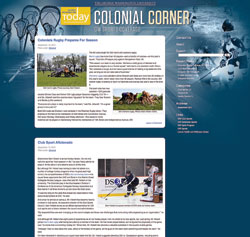 Andrei Afanasev, a prominent theoretical nuclear physicist, has joined GW's Columbian College of Arts and Sciences as the inaugural holder of the Gus Weiss Chair of Theoretical Physics and Energy Studies. Dr. Afanasev comes to GW from Hampton University and the Thomas Jefferson National Accelerator Facility. His research is in the field of nuclear and particle physics probed with high-power electron accelerators and free-electron lasers. The impact of his research ranges from energy sustainability and discovering new elementary particles to developing new technologies for nonproliferation of nuclear materials.
Andrei Afanasev, a prominent theoretical nuclear physicist, has joined GW's Columbian College of Arts and Sciences as the inaugural holder of the Gus Weiss Chair of Theoretical Physics and Energy Studies. Dr. Afanasev comes to GW from Hampton University and the Thomas Jefferson National Accelerator Facility. His research is in the field of nuclear and particle physics probed with high-power electron accelerators and free-electron lasers. The impact of his research ranges from energy sustainability and discovering new elementary particles to developing new technologies for nonproliferation of nuclear materials.
GW Today Debuts Sports Blog
GW has more than 400 varsity athletes and 850 students participating in club and recreational sports. Their efforts representing the Buff & Blue against some of the toughest opponents in the country are now featured on Colonial Corner, a new sports blog launched by the university's official online news source GW Today.
In addition to highlighting the club and varsity programs and individual Colonials who are leading the charge for their teams, Colonial Corner also will cover initiatives focusing on student-athlete leadership, nutrition, and overall wellness.
Visit the blog at www.gwtodaysportsblog.com.
Building the Board of Trustees
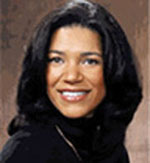
Ann Walker MarchantThe university has welcomed two new members of the GW Board of Trustees as well as a new vice president position focused on board relations.
Ann Walker Marchant and David A. Nadler, BA '70, joined Scott Amey, MS '75, Lee Fensterstock, and Diana Henriques, BA '69, as new members of the board of trustees on July 1. Ms. Marchant is the founder and CEO of the Walker Marchant Group, a public relations firm providing strategic communications counsel and issues management to global corporate brands. Prior to founding WMG, Ms. Marchant served as special assistant to the president and director of research and special projects for communications in the White House for President Bill Clinton.
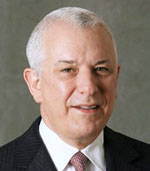
David A. Nadler, BA '70 Mr. Nadler is vice chairman of Marsh & McLennan Companies Inc., a global professional services firm. For 20 years, he was CEO of Delta Consulting Group, which joined Marsh & McLennan in 2000. For more than 30 years, Mr. Nadler consulted with CEOs, boards of directors, and senior executives of major corporations on the design and leadership of large-scale organizational change. He also is the chair of GW's Elliott School of International Affairs International Advisory Council.
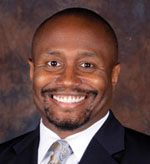
Aristide Collins Jr.
Jessica McConnell Burt
Aristide Collins Jr., who in October 2010 became senior executive director for board relations and secretary of the university, has been named vice president and will continue to serve as secretary of the university.
Mr. Collins is charged with establishing and executing a comprehensive board of trustees office and university secretary function, managing the business affairs, governance, recruitment, communication, and special board events. He also serves as the liaison among the board, senior staff members, and other university constituencies and provides stewardship for official records of the board and the seal of GW.



 The Department of Health Policy at the School of Public Health and Health Services has received a $1.75 million gift from the RCHN Community Health Foundation to support the continuation of the Geiger Gibson Program in Community Health Policy.
The Department of Health Policy at the School of Public Health and Health Services has received a $1.75 million gift from the RCHN Community Health Foundation to support the continuation of the Geiger Gibson Program in Community Health Policy.

 A new program aims to develop the leadership skills of student-athletes with interactive workshops, 360-degree feedback, one-on-one coaching, peer mentoring, and online training.
A new program aims to develop the leadership skills of student-athletes with interactive workshops, 360-degree feedback, one-on-one coaching, peer mentoring, and online training.  Nobel laureate and Pulitzer Prize winner Toni Morrison spoke at Lisner Auditorium in October about race, American history, and how the free food at an informal writers' group helped spur her to work on her acclaimed 1970 novel The Bluest Eye. The university also dedicated a new bench in Ms. Morrison's honor, commemorating Lisner Auditorium's integration in 1947.
Nobel laureate and Pulitzer Prize winner Toni Morrison spoke at Lisner Auditorium in October about race, American history, and how the free food at an informal writers' group helped spur her to work on her acclaimed 1970 novel The Bluest Eye. The university also dedicated a new bench in Ms. Morrison's honor, commemorating Lisner Auditorium's integration in 1947. Former news anchors (from left) Charles Gibson, Brit Hume, Dan Rather, and Frank Sesno joined Marvin Kalb (center) for the September season premiere of the "Kalb Report," where they discussed their experiences on 9/11 and the difficulty of covering such an overwhelming series of events.
Former news anchors (from left) Charles Gibson, Brit Hume, Dan Rather, and Frank Sesno joined Marvin Kalb (center) for the September season premiere of the "Kalb Report," where they discussed their experiences on 9/11 and the difficulty of covering such an overwhelming series of events.  Richard C. Hottelet (left) shared stories from his eight decades in the field as a broadcast journalist, including an encounter with Adolf Hitler, at a master class in August moderated by GW School of Media and Public Affairs Professor and Global Media Institute Director Michael Freedman (right). Mr. Hottelet, who became the only American journalist to be taken prisoner by the Nazis in World War II, began his radio career as a foreign correspondent in Berlin.
Richard C. Hottelet (left) shared stories from his eight decades in the field as a broadcast journalist, including an encounter with Adolf Hitler, at a master class in August moderated by GW School of Media and Public Affairs Professor and Global Media Institute Director Michael Freedman (right). Mr. Hottelet, who became the only American journalist to be taken prisoner by the Nazis in World War II, began his radio career as a foreign correspondent in Berlin. (From left) Former Homeland Security Secretaries Tom Ridge and Michael Chertoff joined current Secretary Janet Napolitano and moderator Adm. Thad Allen, MPA '86, distinguished professor of practice at GW and former commandant of the U.S. Coast Guard, in October to discuss current challenges to homeland security.
(From left) Former Homeland Security Secretaries Tom Ridge and Michael Chertoff joined current Secretary Janet Napolitano and moderator Adm. Thad Allen, MPA '86, distinguished professor of practice at GW and former commandant of the U.S. Coast Guard, in October to discuss current challenges to homeland security.  Former U.S. Secretary of Defense Donald Rumsfeld spoke about his transition from the military to public office at the Minutemen Memorial Building in Northeast D.C. The September event was part of the GW Veterans Campaign Distinguished Speakers Series, hosted by GW Veterans Campaign, the Graduate School of Political Management, and the Reserve Officers Association.
Former U.S. Secretary of Defense Donald Rumsfeld spoke about his transition from the military to public office at the Minutemen Memorial Building in Northeast D.C. The September event was part of the GW Veterans Campaign Distinguished Speakers Series, hosted by GW Veterans Campaign, the Graduate School of Political Management, and the Reserve Officers Association. World Bank President Robert Zoellick addressed the new realities of a world in which developing countries account for a growing share of the global economy in a talk titled "Beyond Aid" at the Jack Morton Auditorium in September.
World Bank President Robert Zoellick addressed the new realities of a world in which developing countries account for a growing share of the global economy in a talk titled "Beyond Aid" at the Jack Morton Auditorium in September. Comedian Bill Maher, host for the past eight years of HBO's Real Time with Bill Maher and No. 38 on Comedy Central's "100 Greatest Stand-Ups of All Time," performed for a sold-out crowd at Colonials Weekend.
Comedian Bill Maher, host for the past eight years of HBO's Real Time with Bill Maher and No. 38 on Comedy Central's "100 Greatest Stand-Ups of All Time," performed for a sold-out crowd at Colonials Weekend.  Renowned D.C.-area chef José Andrés joined his longtime friend Ferran Adrià, former head chef at acclaimed Spanish restaurant El Bulli, at Lisner Auditorium in September to share stories and secrets from their lifetimes spent at the top of the culinary game.
Renowned D.C.-area chef José Andrés joined his longtime friend Ferran Adrià, former head chef at acclaimed Spanish restaurant El Bulli, at Lisner Auditorium in September to share stories and secrets from their lifetimes spent at the top of the culinary game.
 (From left) CNN congressional correspondent Dana Bash, BA '93, former Sen. Robert Bennett, moderator and School of Media and Public Affairs Director Frank Sesno, former U.S. Rep. Harold Ford Jr., and Associate Professor of Political Science John Sides offered their thoughts on the state of the U.S. government and the role of the media in a September panel discussion, "Broken Politics, Mixed-Up Media: Can This Be Fixed?"
(From left) CNN congressional correspondent Dana Bash, BA '93, former Sen. Robert Bennett, moderator and School of Media and Public Affairs Director Frank Sesno, former U.S. Rep. Harold Ford Jr., and Associate Professor of Political Science John Sides offered their thoughts on the state of the U.S. government and the role of the media in a September panel discussion, "Broken Politics, Mixed-Up Media: Can This Be Fixed?" Andrei Afanasev, a prominent theoretical nuclear physicist, has joined GW's Columbian College of Arts and Sciences as the inaugural holder of the Gus Weiss Chair of Theoretical Physics and Energy Studies. Dr. Afanasev comes to GW from Hampton University and the Thomas Jefferson National Accelerator Facility. His research is in the field of nuclear and particle physics probed with high-power electron accelerators and free-electron lasers. The impact of his research ranges from energy sustainability and discovering new elementary particles to developing new technologies for nonproliferation of nuclear materials.
Andrei Afanasev, a prominent theoretical nuclear physicist, has joined GW's Columbian College of Arts and Sciences as the inaugural holder of the Gus Weiss Chair of Theoretical Physics and Energy Studies. Dr. Afanasev comes to GW from Hampton University and the Thomas Jefferson National Accelerator Facility. His research is in the field of nuclear and particle physics probed with high-power electron accelerators and free-electron lasers. The impact of his research ranges from energy sustainability and discovering new elementary particles to developing new technologies for nonproliferation of nuclear materials.

